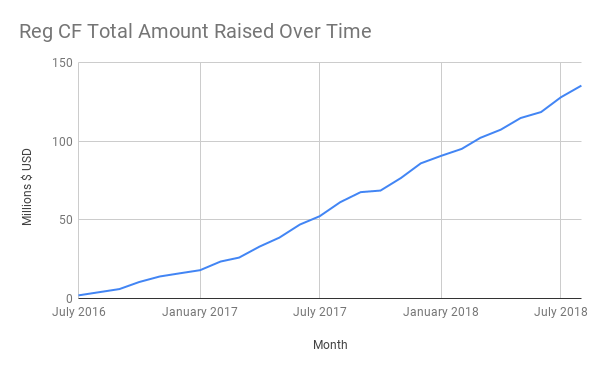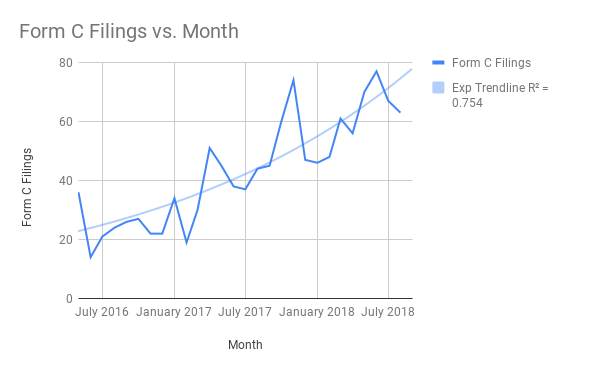Part 1 – What is Equity Crowdfunding?

This is Part 1 of a five-part getting started investor series to provide a brief introduction to equity crowdfunding.
————
A New Type of Investment – Equity Crowdfunding
 If you’re anything like me, you probably have prior experience in some type of investing. Maybe you own some stocks or bonds. Perhaps you have some real estate. Or you contribute to an employer’s retirement plan or an IRA.
If you’re anything like me, you probably have prior experience in some type of investing. Maybe you own some stocks or bonds. Perhaps you have some real estate. Or you contribute to an employer’s retirement plan or an IRA.
There are seemingly infinite ways to invest your money, and options can quickly get overwhelming. Especially for the many Americans (like me) that work a full-time, non-finance related job, and just handle their investments on the side.
Due to the potential of being overwhelmed, and with this new – and I believe game-changing – opportunity now available called equity crowdfunding, I have decided to create the CrowdWise community to help introduce both new and experienced investors alike to startup investing.
Investing in startups isn’t actually new. However, due to the risk, the SEC has historically restricted anyone except the most wealthy investors from investing in startups and private equity. That has meant that everyday investors like you and me could not invest in startups, going all the way back to the 1930s.
What changed? The JOBS Act of 2012 made provisions for something called Title, III or Regulation Crowdfunding (Reg CF), which went into effect in May of 2016.
Now, any American, regardless of income or financial background, can invest in startups.
The private equity markets can be a scary place to put your money. But we hope to demonstrate they can also be a potentially lucrative and educational place if you know what you’re doing.
Thus, I hope to introduce you to the basics of equity crowdfunding in this five-part series and help you decide whether investing in equity crowdfunding is right for you.
Let’s jump right in.
How I discovered Equity Crowdfunding
I do a monthly, quarterly, and annual goal-setting process, and one of my goals this year was to “boost the potential returns of my portfolio while diversifying my investments”. A noble goal, but one that seems to get harder year after year as I continue to diversify. Remaining investment options seem to become fewer and fewer.
Because I was already invested in stocks (domestic and international), bonds, real estate, and even some alternative investments including peer-to-peer debt lending and crowd-sourced real-estate, I started searching the web for other investments that I may not have heard of.
One day I was on Skype having a video chat with a close friend. We were talking about how Venture Capital and Angel Investors can invest in early-stage companies, long before they are offered on the public markets. An extremely high-risk, high-reward investing opportunity, for sure.
“If only there was a way we – as typical investors (i.e. non-accredited) – could invest in startups. If used wisely with asset allocation and diversification, I think that could actually be a part of a sound investment strategy,” I said.
After the call, I did some Google searches. I looked for “investing in startups”, “investing in early-stage companies”, “private equity investing”, and “Angel investing in small amounts.” Finally, I found what I was searching for.
It was called equity crowdfunding. And it has only been around and legal since 2016.
What is Equity Crowdfunding?
 By definition, equity crowdfunding is the offering and sale of private securities (such as stock, convertible debt, SAFEs, and other securities) to a group of investors, typically for much smaller amounts per investor than traditional Angel or Venture Capital investors.
By definition, equity crowdfunding is the offering and sale of private securities (such as stock, convertible debt, SAFEs, and other securities) to a group of investors, typically for much smaller amounts per investor than traditional Angel or Venture Capital investors.
Most people have probably heard of crowdfunding campaigns on websites like Kickstarter or Indiegogo.
While the basic idea behind the crowd support is the same, there is one key difference between Kickstarter – referred to as “rewards” based crowdfunding – and this new way of investing, called “equity” crowdfunding.
When you invest in a campaign on Kickstarter, you may receive a t-shirt, an initial release of the product that they are developing, or other special perks. That’s great! However, after this one-time exchange of your support funds for a given reward, that is it.
Instead, imagine if you were able to invest in the company itself and share in any future successes. Think of investing like stocks, except that you have access to the companies long before they are listed on a public stock exchange.
That’s the essence of equity crowdfund investing.
The History of Startup Investing
You have likely heard of Angel Investors, or perhaps Venture Capital (VC) funds that invest in early-stage startups like Facebook, PayPal, Uber, Twitter, and many others. Similarly, you have likely heard stories of how some of the earliest investors of these companies made 10X, 100X, sometimes more than 1000X their money.
The problem is that, since 1933, the SEC has prohibited you (and me) – those who are called non-accredited investors who make under $200k a year or have under $1 million net worth – from investing in startups and private businesses.
We can still invest in relatively new companies when they start trading on public exchanges like the NASDAQ and New York Stock Exchange through an Initial Public Offering (IPO). However, by that time, many investors – Angels and VCs – have already been invested in the company for years. Thus, their initial investments have grown already by 10X, 100X, or even more on day one of the IPO.
 That all has changed thanks to the Jumpstart Our Business Startups (JOBS) Act of 2012. Investing in startups and early-stage companies – formally called equity crowdfunding – is now available to all investors at all income levels.
That all has changed thanks to the Jumpstart Our Business Startups (JOBS) Act of 2012. Investing in startups and early-stage companies – formally called equity crowdfunding – is now available to all investors at all income levels.
May 2016 arguably marked one of the most important dates in non-accredited investors’ history since the formation of the Securities and Exchange Commission (SEC) in the 1930s. May 2016 was when the first-ever funding portals for equity crowdfunding went live.
Funding portals are the websites that allow startups to raise funds in exchange for equity from the crowd. Most important for you, it is where you can go to see the current deals and choose to invest in them.
The growth – as measured by both investment dollars and number of filings – has been continuing to grow since that date. Check out the trends from Form C filings with the SEC.


An investor revolution in the making?
Until 2016, non-accredited investors – meaning most Americans, who don’t make over $200k a year or have $1 million net worth – could not invest in private, pre-IPO companies.
Now, equity crowdfunding and new laws called Regulation Crowdfunding (Reg CF) allow investors like you and me to invest in early-stage companies, long before they sell stock to the public.
This is a huge opportunity to both investors and startups alike. Let’s investigate a few of the benefits to both startups and investors, and see how it differs from traditional Angel or VC investing.
Benefits of Equity Crowdfunding for Startups
Some of benefits for startups are:
- Access to additional capital, through new investors who traditionally could not invest in private companies
- Access to investors around the globe – not restricted to geographical limitations
- Lower costs of paperwork and legal fees compared to traditional raises
- Ability to sell some equity without giving up voting rights or control (Equity CF shares typically do not come with voting and/or pro-rata rights)
- Ability to develop a greater number of “brand champions” and supporters for your product
- Increases diversity of investor base, allowing more non-traditional types of investors to fund companies that may not have typically been funded by an Angel or VC
Equity crowdfunding opens up an entirely new funding source for startups to raise capital by removing barriers like geographic location, dependence on existing investor networks, restrictions on types of investors.
While accredited investors, Angels, and VC firms have invested in startups for a long time, they have some unique limitations, including:
- Large investment minimums – trying to deploy millions of dollars via many small investments would take far too long for larger Angels and VC firms to deploy capital
- Bandwidth limitations – investments of larger amounts typically come with more responsibility to the company invested in, and may require bandwidth to help with company’s operations
- Geographical limitations – historically it was necessary to be located geographically near your investments (or be willing to make frequent business trips)
The minimum amount that startups would typically accept from an Angel was on the order of $25,000, and it easily could be on the order of $100-150k. In exchange for the funds, the lead investor is typically also involved in the early stages of the startup, providing mentoring, networking, helping with interviews, and anything else that they deem necessary to give their investment the best chance of success.
There are pros and cons to this, since the investors had much more direct influence and interaction with the company. However, it does come with additional downsides and responsibilities as mentioned above.
Now, equity crowdfunding allows investing in much smaller minimum amounts, on the order of $100, $250, $500.
This means investors can now much more easily diversify among many startups than was possible in the past. In addition, it lowers the minimum capital barrier to entry, since investors who don’t have $25,000 to put down on a single deal may now invest.
Benefits of Equity Crowdfunding for Investors
Some of benefits for investors are:
- Portfolio diversification – new venture asset class now available to non-accredited investors
- Potential for higher returns – with the associated increase in risk
- Ability to spread startup investment dollars among many companies due to the smaller minimum investments, to diversify your risk and more easily build a “portfolio” of startup investments
- Access to early-stage companies you are passionate about supporting
- Increases “deal flow” for investors, or the amount of potential investments that they have the opportunity of investing in
On the investor side, this is an entirely new asset class that you can add to your investment portfolio. While there is the remote and rare possibility of having 100X or 1000X returns, we believe – when invested in wisely by using diversification and asset allocation strategies that CrowdWise will discuss – it can be a great asset to add to your investment portfolio with stocks, bonds, and real estate.
Furthermore, even accredited investors – who were already able to invest in startups – now have the ability to invest with much smaller sums of money. As the funding platforms have matured, more and more deals are becoming available, meaning it gives even accredited investors the option to diversify their investments within startups in a way never before possible.

Lastly, putting the potential returns aside, it gives investors the opportunity to invest in early-stage companies they truly believe in.
It is impossible to know the number of companies that did not bring a new technology into the world due to early funding issues, but with a new worldwide community able to invest, there will be a better chance for more unknown startups to give their idea a shot. And by giving more non-traditional companies a chance to succeed, it will inevitably bring more later-stage investing opportunities that do succeed to Angels and VCs, which they may have otherwise not seen.
How Does Equity Crowdfunding Differ from Other Types of Crowdfunding?
Crowdfunding is essentially any campaign where an entity – either an individual or a company – can raise funds and capital from others (i.e. the “crowd”).

However, there are several types of crowdfunding, so it is important to distinguish between:
- Rewards-based crowdfunding (e.g. Kickstarter, Indiegogo)
- Equity crowdfunding (also called startup investing, crowdinvesting, and many other names)
- Debt-based crowdfunding (e.g. peer-to-peer loan sites like LendingClub, Prosper)
Equity crowdfunding is a type of crowdfunding, along with other types like rewards-based crowdfunding sites (e.g. Kickstarter) and debt-based crowdfunding sites (e.g. Prosper and LendingClub).

Rewards-based or donation-based crowdfunding
Companies like Kickstarter and Indiegogo are called rewards-based crowdfunding. The reason is anyone who chooses to support a campaign by contributing money will receive a one-time reward in return for their investment dollars. Typically, this could be a t-shirt, an early-release of a prototype, a signed photo, or some other combination of goods or services in exchange for their funds.
This is great, especially if what you are interested in is getting early access to the product, or being one of the early supporters.
However, let’s say that company does extremely well, and eventually grows to the point where they are acquired by a larger company for a large sum of money, or maybe even decide to do an Initial Public Offering (IPO).
What does that mean for you as an “investor”? Well, if you supported them via Kickstarter, you would probably get an update from the company, thanking you for being one of the supporters that got them there. Your one-time reward was already provided when you invested your initial dollars, so you would not receive anything else in return.
Equity crowdfunding
Instead, let’s assume that you supported this company via the new way of investing called equity crowdfunding, also referred to as startup investing or crowdinvesting. When you initially invested your money, instead of a one-time product or t-shirt, you actually gained shares of the company, or equity.
Thus, if that company does decide to go public or gets acquired, your initial investment is now potentially a slice of a much larger pie, and so you share in the success of the company.
That could take 3, 5, even 7 years or more, as the life of a startup is highly unpredictable. Furthermore, there is a high risk that the startup will fail, and you will never see any of your money again.
Thus, it is critically important that investors in startups understand the risks and strategies necessary to mitigate some of those risks, and that is exactly what we will aim to provide with the CrowdWise community.
Debt-based crowdfunding
A third form of crowdfunding that CrowdWise will not cover is debt-based crowdfunding. These are peer-to-peer lending platforms that cut out the middle man (i.e. banks) from lending, and put the borrowers (i.e. those requiring money) directly in contact with the investors.
The borrowers typically are looking for a large, one-time loan – say to refinance high credit card debt – and receive a lower interest rate than they may already be paying. They pay back a fixed percentage loan each month, and so it is called “debt-based” crowdfunding in that sense.
I am an investor in peer-to-peer lending and it can be a solid part of a portfolio. However, the focus of CrowdWise will be specifically on equity crowdfunding.
What CrowdWise Will Not Focus on Initially
Debt-based crowdfunding: equity crowdfunding, according to the JOBS Act legislation, is broad. Thus, some deals on the funding platforms may be debt-based deals, or a combination of debt and equity in something like a convertible note. The initial focus of CrowdWise will be on the equity deals and the essentials to get started for investors to add this asset class to their portfolio, and not on the purely debt-based or revenue-sharing deals.
Crowd-sourced real estate: furthermore, many crowdsourced real estate sites like Fundrise and others also offer both debt and equity options for investors in real estate. CrowdWise will not include any real estate discussion at the start, due to the different nature of investing in real estate vs. investing in companies.
Summary of Equity Crowdfunding
At this point, we have covered what equity crowdfunding is and started to touch upon a few of the reasons why it should be of great interest to investors.
If you are anything like me, however, you probably have a lot more questions than answers right now in terms of equity crowdfunding.
In Part 2 of this five-part series, we will start to dive into the risks vs. rewards of equity crowdfunding.
By the end of this five-part introductory series, we hope to answer all the questions below (and more):
- What is equity crowdfunding? (Part 1)
- Top four reasons to invest in startups via equity crowdfunding (Part 2)
- Types of companies and investor-founder goal alignment (Part 3)
- Types of offerings and deal terms (Part 4)
- How to get started investing in equity crowdfunding (Part 5)
How can I learn more?
If you are interested in learning more about how to get started ASAP, check out our free courses at CrowdWise Academy.
It is completely free to sign up and also join our mailing list. We will promise to never spam you, and will aim to only provide relevant resources that you are interested in.
Also, head on over to our books page for reviews and summaries of books that introduce you to key concepts to help you successfully invest in equity crowdfunding.






[…] Regulation Crowdfunding (Reg CF) has only existed since 2016, this should come as no […]
[…] overlook one important topic that may only come up once a year – taxes. While the ability for non-accredited retail investors to invest in private markets may be new, the tax laws around private market investing are […]
[…] that equity crowdfunding is another one of those trends. It has slowly been gaining adoption since Title III of the JOBS Act went live in the United States in 2016, but the pandemic gave it an extra boost this past […]
[…] crowdfunding is any other a kind of developments. It has slowly been gaining adoption since Identify III of the JOBS Act went are living in the USA in 2016, however the pandemic gave it an additional spice up this […]